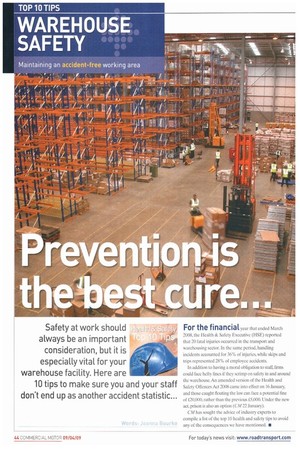For the financial year that ended March 2008, the Health
Page 44

Page 45

If you've noticed an error in this article please click here to report it so we can fix it.
& Safety Executive (HSE) reported that 20 fatal injuries occurred in the transport and warehousing sector. In the same period, handling incidents accounted for 36% of injuries, while skips and trips represented 28% of employee accidents.
In addition to having a moral obligation to staff, firms could face hefty fines if they scrimp on safety in and around the warehouse. An amended version of the Health and Safety Offences Act 2008 came into effect on 16 January, and those caught flouting the law can face a potential fine of £20,000, rather than the previous £5,000. Under the new act, prison is also an option (CM 22 January).
CM has sought the advice of industry experts to compile a list of the top 10 health and safety tips to avoid any of the consequences we have mentioned.
1. Maintain a fixed routine
Consultant Chris Williams at consultancy CSTR services suggests a simple tick list of 'building opening' and 'building closing' will ensure every person and item is in order to make operations run smoothly in a knowingly safe environment.
2. Spot checks
An employee could run unexpected checks which would keep staff on their toes and make them realise safety measures should always be maintained rather than just sharpening up when an inspection is planned.
3. High-visibility clothing
By all warehousing operators that CM questioned, the need for hi-vis clothing was rated as an essential safety requirement.
On a recent visit to the Manchester-based haulier AK Worthington, CM was asked immediately to wear a high-vis jacket in the warehouse to identify us as someone who is not familiar with the surroundings and could pose a danger to others or ourselves. Here are our experiences: "Upon visiting the Manchester-based distribution company AK Worthington it was stressed that as a visitor I must wear a high-vis jacket because the company policy is that all staff and visitors must wear them. Also, all visitors must be escorted around the warehouse as someone who is not familiar with the immediate surroundings and could pose a danger to others and themselves.
"Simple measures prevent potentially fatal accidents."' Other useful safety items to wear include gloves and safety boots.
4. Risk assessments
According to Peter Brammah, the director of training at The Resources Group, the first port of call for companies is to carry out a risk assessment. He elaborates: "Companies need to do these more and more, and what follows from this is we can work out how to get around the problems.They are carried out by an instructor with a candidate so they can understand exactly why changes may be necessary.
5. Training courses
Following a risk assessment, firms can identify where improvement might be needed and select courses for their staff to help achieve a safer environment. It could be a course in forklift training or one explaining how to work safely at height.
Although it can prove costly, companies could opt to train two people dedicated to a job rather than employing several who are partially trained. Training should be updated on a regular basis, with Williams recommending annual refresher courses.
6. Determine where responsibility lies
A spokesman at Northampton College says: "Someone should have separate responsibility for safety based on adherence to rules. So. if an employee walks outside a defined pedestrian area, a Material Handling Equipment (MHE) driver is not held responsible for an accident."
7. Keep pedestrian traffic to a minimum
Minimising pedestrian traffic is always a plus, says John Stirrup, director of Stevenage-based Becker Transport. By using designated pedestrian walkways, staff on foot can avoid collisions with forklifts or heavy machinery.
8. Warnings
A combination of speed limits and lights and sounders on forklifts can heighten awareness of the dangers in and around the warehouse.
9. Simplicity
Clutter should be replaced with clear working and storage areas. Good lighting, ensuring barriers are always replaced on mezzanine floors and visible warning signs are all measures to help prevent accidents.
10. The four 'Es'
Brammah believes the four following points make for a disciplined and safe warehouse: • Education — training, signs and information.
• Encouragement — incentives and staff rewards.
• Enforcement — restrictions on where and when you can be in the warehouse.
• Engineering — layouts and traffic management.
















































































































































